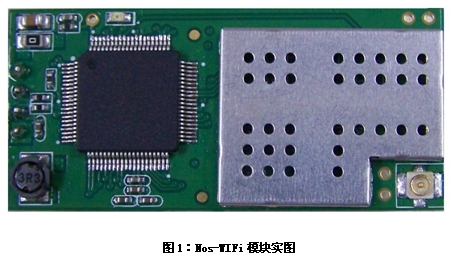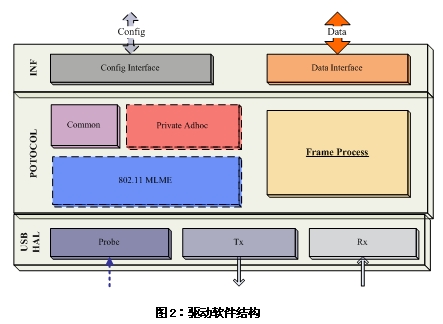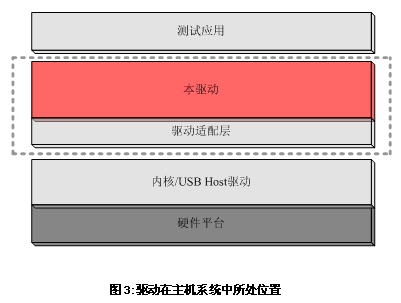The principle and application of WiFi without operating system
At present, in wireless monitoring, industrial control, video transmission and other industry applications, embedded wireless systems mainly use a no operating system environment represented by the NORDIC solution, which consists of "CPU + wireless data transmission module" and can achieve short distances. Low-bandwidth wireless communication. However, due to the technical limitations of narrowband wireless communication, it can only achieve a maximum transmission rate of 2 Mbps, corresponding to the actual video transmission, which can only meet the application of less than 15 frames per second at 320 * 240 within 10 meters. With the market demand for larger screens, faster transmission rates, and smoother video effects, this solution will be far from meeting people's needs. System upgrade requires broadband wireless transmission equipment such as WLAN. The traditional upgrade method is to add Flash and SDRam under the original system architecture and run an embedded operating system to drive the WLAN module, which not only greatly increases the system cost, but also product development The difficulty increases and the cycle lengthens, which is not conducive to the introduction of new products.
As the most widely used technology in wireless local area network communication, WLAN has gradually extended from the PC / notebook market to audio and video, handheld terminals, wireless city coverage, industrial applications and other aspects of people's daily lives, bringing people's lives into a convenient The era of intelligent wireless.
The Nos-WiFi product (shown in Figure 1) launched by Beijing CLP Huada Electronic Design Co., Ltd. has changed this situation. Huada Electronics has devoted itself to the research and development of WiFi core chips and module products for many years. So far, it has successfully mass-produced three chips of the Airquick series (Airquick) that also support the domestic (WAPI) / international (11i) security standards, and Based on this, nearly ten WLAN module products have been launched. The product applications cover various fields such as notebooks, USB external wireless network cards, home audio and video, security monitoring, operator hotspot products, home gateways, industrial applications, and intelligent transportation.

Nos-WiFi series module products are developed to meet the needs of wireless function upgrades of existing products in industrial applications, security monitoring and other fields. Its biggest feature is that it provides a driver software that is not based on any operating system. Can be integrated into any system platform to run, and achieve high-speed data transmission, making it possible to use WiFi for video transmission without an operating system. Its driver software structure is shown in Figure 2:

The location of this product integrated into the host system is shown in Figure 3:

Nos-WiFi features and status
For most USB wireless modules based on the 802.11b / g / n standard on the market, most of them are used on the PC platform. Therefore, manufacturers of these usb wireless modules usually only provide Windows or Linux-based environments. Drivers, corresponding to embedded applications, only use embedded system platforms such as WinCE, embedded linux operating system to apply these products. For embedded devices with limited hardware resources and low processing power, WinCE and embedded linux are undoubtedly a behemoth. They only use some simple operating systems that support scheduling functions or even do not use any operating systems. The only choice. There is no USB wireless module available on these systems. Even if these manufacturers are forced to upgrade the hardware of the system to meet the needs of using USB wireless modules, the resulting increased cost greatly reduces the competitiveness of the products. For example, in a typical Linux operating system-based embedded device that supports WiFi functionality, in order to support the operating system, the hardware architecture requirement is "CPU + 32MB SDRAM + 32MB FLASH", while in an embedded device that does not run the operating system Inside, the hardware architecture can be changed to "CPU + 8MB SDRAM + 1MB Serial flash", and the resulting cost difference is about $ 4. Considering the difference in the price of the main CPU, the overall cost of the device in the operating system environment is about 6 different US dollars.
At present, the wireless data transparent transmission business field without operating system environment mainly uses 2.4Ghz private protocol wireless data transmission modules (non-standard WiFi products) of companies such as Zigbee or Nordic, but these products can only be realized within a short distance (about 10m) With a data throughput rate of about 2Mbps, it is impossible to achieve indoor and long-distance data transmission with large amounts of data. The wireless transmission scheme using Nos-Wifi products, based on the WiFi transmission technology of the 802.11g standard, the maximum transmission rate of the physical layer can reach 54Mbps, even if the outdoor coverage is 100 meters, the physical layer transmission rate of 5.5Mbps can still be achieved, making Long-distance, high-throughput data transmission becomes possible.
Typical applications of Nos-Wifi products
Streaming TV
In the general environment where modern life is advancing toward digitalization and networking, the 3c integration of home appliances has become an inevitable product development trend, and the status of TV as the display center of modern homes is unshakable. Therefore, streaming media TV came into being. Streaming TV can not only watch clearer TV programs, but also play pictures, music, movies in digital devices such as digital cameras and mobile hard drives for the whole family to enjoy together.
The combination of streaming TV and WiFi technology allows people to directly connect to the home computer through the wireless network, so as to directly play the streaming media files stored on the computer, and even further, use the wireless network to access the Internet network through the home wireless router. Realize the real network online playback function. Nos-Wifi products make it easier to add WiFi functionality to streaming TV.
Wireless security, video surveillance
In peer-to-peer wireless communication applications, such as baby monitor and other monitoring products, Nos WiFi can better show its advantages.
Baby Monitor, that is baby monitor, is a small radio transmission device, including transmitter and receiver. The transmitter is placed next to the baby, equipped with a microphone and a camera, and every subtle sound and action from the baby can be accurately recorded, and a clear signal is sent through the antenna on the transmitter. The receiver is a portable handheld display that receives these signals and is carried by parents. With this device, parents can handle other affairs in other rooms and even in outdoor courtyards, and at the same time, they are well aware of the child's situation.
Industrial control, intelligent transportation
Modern industrial control has higher and higher requirements on the networking capability of the system, and the complexity of industrial control is getting higher and higher. Therefore, the resource limitation of the CPU in industrial control is also increasing. This module product can easily upgrade the existing system without changing the system's large structure. Upgrade the existing system to a wireless TCP / IP network.
Similarly, the modern functional transportation field requires higher and higher system networking capabilities and system networking flexibility. Nos-wifi can easily upgrade the original system. The transportation facilities can be easily connected to the TCP / IP network.
A rice cooker or rice steamer is an automated kitchen appliance designed to boil or steam rice. It consists of a heat source, a cooking bowl, and a thermostat. The thermostat measures the temperature of the cooking bowl and controls the heat. Complex rice cookers may have many more sensors and other components, and may be multipurpose. Cooking rice has traditionally required constant attention to ensure the rice was cooked properly, and not burnt. Electric rice cookers automate the process by mechanically or electronically controlling heat and timing, thus freeing up a heating element on the cooking range that had to be otherwise occupied for rice cooking. Although the rice cooker does not necessarily speed up the cooking process, with an electric rice cooker the cook's involvement in cooking rice is reduced to simply measuring the rice, preparing the rice properly and using the correct amount of water. Once the rice cooker is set to cook, the rice will be cooked with no further attention.
Features:
For modern home rice cookers, the smallest single-person model cooks 1 rice cup (180 ml), whereas large models can cook 10 cups. Commercial models can cook 20 or more cups. As a possible source of confusion, model specifications and names may list either cooked or uncooked capacity. Rice roughly doubles in size during cooking; therefore, a 10 cup (uncooked) rice cooker can produce up to 20 cups of cooked rice. The prices vary greatly, depending on the capacity, features, materials used, and the country of origin.
The majority of modern electric rice cookers are equipped with a stay-warm or keep-warm feature, which keeps the rice at an optimal temperature for serving without over-cooking it. Some gas cookers also have electric stay-warm mechanism. However, the usefulness of this feature degrades over time, a microwave may be more energy efficient or better suited to reheat rice that will sit longer than four hours.
Some rice cookers use induction heating, with one or more induction heaters directly warming the pot. This can improve energy efficiency.
Most modern rice cookers use aluminium for the inner cooking bowl. There are some models that use stainless steel instead of aluminium. Various other materials, such as copper, pure carbon, ceramic, and diamond powder coating, may be used for higher heat conductivity or better taste.
The pressure-cooking models can raise the water's boiling point higher, e.g., from 100 °C at 1.0 atm up to about 110 °C at 1.4 atm, which speeds cooking. The pressure-cooking models can also be used in high altitude areas, where the boiling temperature is below 100 Celsius. Pressure cookers are also suitable for cooking brown rice (which contains oils and bran fiber that cook differently from pure white rice starch). Some pressure rice cookers have a varying pressure control mechanism (named the "dual-pressure" method) that creates repeated pressure/release cycles during the cooking.
There also exist mechanisms to collect and return the boiled over liquid to the inner rice bowl.
Many cookers now have microprocessor-controlled cooking cycles, which are often used to adjust for rice and cooking type.
Applications
Rice cookers are typically used for the preparation of plain or lightly seasoned rice. Each rice cooker model may be optimized to cook a certain type of rice best. For example, most Japanese rice cookers are optimized for cooking Japanese rice and may not be the best for other types of rice[citation needed], although cooking time can be lengthened simply by more water.
The typical method of cooking long grain rice is boil-and-strain and/or steaming method. The absorption method used in Japanese rice cookers will produce slightly different texture and taste, usually stickier rice.
Brown rice generally needs longer cooking times than white rice, unless it is broken or flourblasted (which perforates the bran).
Different varieties of rice need different cooking times, depending on their grain size, grain shape, and grain composition. There are three main types of Asian rice: Oryza sativa subsp. indica, i.e., Indian rice (long grain rice, e.g., basmati rice and Thai jasmine rice), O. sativa subsp. javanica, i.e., Java rice (large grain rice) and O. sativa subsp. japonica, i.e., Japanese rice (medium grain rice, e.g., Calrose rice, short grain rice, e.g., most Japanese rice and risotto rice).
African rice, Oryza glaberrima, is an entirely separate species, but can be cooked in the same way. Zizania is not even in the same genus, although it is often called a rice (or "water oats"); it, too, can also be cooked in a rice cooker.
A rice cooker can be used to cook many boiled or steamed granular foods, such as pot barley, bulgar wheat, and dal. Provided the ingredients have similar cooking times, a rice cooker can cook mixtures such as khichdi. Some rice cookers can be used as automated couscoussiers, cooking couscous and a stew simultaneously.
Rice Cooker
Rice Cooker,Drum Rice Cooker,Deluxe Rice Cooker,Straight Rice Cooker
Guangzhou Taipeng Electrical Appliances Technology CO., LTD. , https://www.kettles.pl